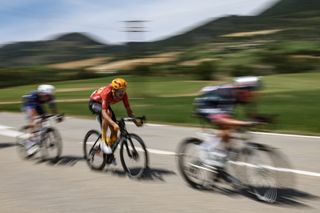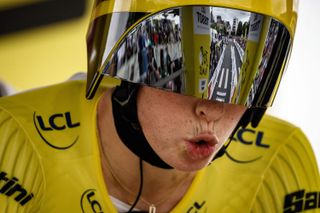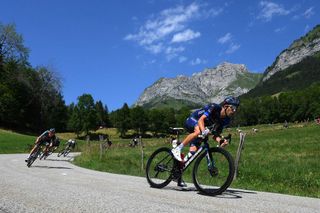In 2022, the Tour de France hit its quickest common velocity of the trendy period at a startling 42.03kph. It is hardly an outlier, with data throughout Cobbled Classics, multi-day stage races and all variety of historic climbs tumbling in recent times. Biking is changing into sooner and sooner – a difficulty which has provoked many important conversations round security, but additionally begs the query of why velocity has elevated, and extra importantly when that pattern could start to decelerate.
Properly, after discovering the most recent technical, physiological and strategic improvements mooted on the world’s largest biking science convention, it’s no time quickly.
The Science & Biking Convention is a street bicycle owner’s dream the place the biking world’s biggest brains assemble for 2 days of shows, workshops and masterclasses on both the most recent advances on the skilled circuit or inside the labs.
It takes place yearly within the week earlier than the Tour de France Grand Depart with the latest version occurring in Florence, Italy. Together with WorldTour practitioners and main lecturers, Cyclingnews was in attendance and one of many key dialogue factors was the key features nonetheless to be made in biking velocity.
Aero revolution?
For years, aerodynamic sensors have flirted with a breakthrough, the likes of Notio – a spin-off of Argon-18 – utilized by consultants at WorldTour groups and coaches however not deemed usable sufficient for mass consumption. Corporations proceed to work on a coaching instrument that, in concept, might have the identical influence on elite and newbie cyclists as energy meters. That features the model who’ve created fairly a buzz in current occasions, UK-based Physique Rocket, whose buyers embody Alex Dowsett.
The Physique Rocket system contains sensors that connect to your seatpost and handlebars, plus sensor-loaded pedals that exchange your present pedals. An air-speed sensor can also be included that attaches to the entrance of your bike.
In Florence, Physique Rocket’s tech wizard Callum Barnes, or “Einstein”, revealed how the system could possibly be the one that would – we repeat, ‘might’ – lay the foundations for aerodynamic sensors changing into a driving staple.
“We in contrast drag-force measurements carried out concurrently in a wind tunnel and the Physique Rocket gadget and, on common, the Physique Rocket system agreed inside 2.3% of the wind-tunnel knowledge, underneath completely different wind speeds, yaw angles and physique positions, and reliably detects aerodynamic features as a result of positional and gear adjustments,” Barnes defined. “As a byproduct of its design, it additionally permits monitoring of biking positions, offering worthwhile suggestions in any other case not accessible to the athlete.”
This clearly was no unbiased research – we stay up for unbiased research and real-life suggestions – however there’s a sense that this might – once more, might – be the one, partly as a result of it’s such a unique aero strategy than different efforts available on the market.
“The Physique Rocket system’s basically completely different to different aero sensors because it does away with estimations i.e. measuring airspeed and energy then again calculating to seek out drag,” mentioned Barnes. “As an alternative, it instantly measures drag via sensors on the contact factors of the bike offering a way more correct drag worth and CdA [co-efficient of drag multiplied by frontal area’. This is why the Body Rocket system is the only system where it’s possible to make direct comparisons with that measured in the wind tunnel.”
Barnes also presented a machine-learning project he’s working on. “There’s still work to be done but it’d allow for the user to know what position they are in at every moment in time and when the conditions change, or the athlete is on a different part of the course they can then be notified to change position, optimising themselves live. This shifts the focus from thinking you only have one optimal position to having numerous for different conditions and courses.”
There’s no public deadline for that project. There is for the Body Rocket system, which will be available to consumers from May of this year for £2,950.
Sign up to the Musette – our subscriber-only newsletter
Turning a corner (fast)
While aerodynamics is the easiest area to imagine gains in speed, some of the most pivotal changes in overall rider speed could happen when a bike travels at its very slowest.
“How proficient you are at cornering is vital,” said Uno-X sports scientist Thomas Lagoute. “There are many turns in road races – many of them are 90° or even more – and coaches see them as potentially decisive features in a race. Even less acute turns can be important if they’re positioned before key efforts such as climbs or cobbled sectors. This is due to the accordion effect [a term in physics whereby fluctuations in the motion of a travelling body cause disruptions in the flow of elements following it] and subsequent tactical requirements to manage the race.”
To that finish, Lagoute analysed Uno-X rider knowledge via 10 corners at Gent-Wevelgem. Through GPS and energy knowledge, Lagoute examined nook entry and exit velocity, the power price of recovering that misplaced velocity and the utmost energy output via the corners.
“Sharp corners have a typical ‘anatomy’,” Lagoute added. “They usually end in a discount in energy into the flip and a brief however massive energy surge popping out of the apex that’s nicely above important energy [i.e. severe intensity domain].
“For half of the riders we investigated, this surge was above their maximal 60-second energy. The buildup of these high-intensity efforts can scale back the flexibility to mobilise excessive energy on the decisive second of the race.”

All in all, Lagoute revealed, a “low estimate” could be that over 10% of the whole power expended within the ‘purple zone’ is related to cornering sections. And that extra skilled riders spent much less time burning via excessive ranges of power throughout these sections.
What does this imply for professional riders and amateurs alike? “Finally, we’re speaking about acceleration – the much less velocity you lose throughout a nook, the much less it’s important to regain afterward,” mentioned Lagoute. “So, apart from positioning – it’s higher to have a transparent strategy to nook effectively – bettering cornering method’s a should. To that finish, having a crack at disciplines like cyclo-cross could be a helpful train.
“Additionally notice that when you’re racing an city occasion like a criterium, there’s a tactical trade-off between dealing with extra wind on the entrance versus the acceleration prices of being out again and correcting the accordion results after a flip. This would possibly require taking part in round with to see how you’re feeling in each eventualities.”
Lagoute signed off by suggesting that ‘flip evaluation’ would turn into extra in style and may have a look at detailed suggestions on downhill sections the place method is much more essential. “Additional analysis must also examine the velocity and energy patterns of various riders whereas cornering (lack of velocity, smoothness of acceleration, torque/cadence),” he mentioned. “A deal with the physiological variables is also of curiosity; in different phrases, how lengthy does it take to get well from that energy spurt.”
How respiratory monitoring can enhance efficiency
Coronary heart fee, energy output, coronary heart fee variability, sweat fee, blood glucose… Street biking in 2025 is metric insanity with, when you select, each cell in your physique underneath surveillance within the hope of driving stronger and longer. So, it appears considerably incongruous that the motion you’re arguably most conscious of when biking – your respiratory – stays analysis-free. However that could possibly be set to alter…
Tyme Put on is a US firm that’s been round since 2014, of which a lot of that interval has been spent engaged on a wise shirt. Rounds of funding have seen the attire come to market.
How does it work? A sensor tracks respiratory fee, respiratory quantity and minute air flow, which it might probably then use to find out a rider’s first (VT1) and second ventilatory thresholds (VT2) plus their VO2max.
To dig a bit deeper, VT1 is a marker of depth noticed in an athlete’s respiratory at some extent the place lactate begins to build up within the blood. Because the depth of driving cranks up, VT1 is recognized on the level the place the respiratory fee cranks up. You’ll know once you’re at VT1 as you’ll now not be able to speaking comfortably.
VT2 is when lactate is quickly stacking up within the blood and also you’re respiratory closely. Now, talking is now not doable. VT2’s also referred to as the respiratory compensation threshold (RCT) and the onset of blood lactate accumulation (OBLA).

These are generally calculated within the lab through respiratory equipment to evaluate how laborious your physique is working and, in the end, create particular coaching zones for particular coaching variations. Which, down the road, with constant coaching will make you a sooner, stronger bicycle owner.
That’s all very nicely, after all, however how legitimate are the outcomes? In keeping with PhD researcher Giuseppe Greco of the College of Rome, extraordinarily. Greco and his crew had six competent street cyclists of their early- to mid-20s, who weighed round 69kg with a VO2max of just below 60ml/kg/min, carry out an intermittent train check and a ramp check, which will increase energy output each minute.
The intermittent check consisted of 10 robust 10-second bursts interspersed with 50-second bouts of restoration. Effort cranked up by 10% with every burst till they’d reached capability within the remaining set. The ramp check then began from simply 20 watts with energy output rising by 30 watts per minute till the riders had reached exhaustion. Respiratory and heart-rate response was measured through each the Tyme Put on good shirt and the gold-standard respiratory equipment.
What did Greco and his crew discover? That the Tyme Put on sensor proved spectacular in opposition to the gold commonplace and higher than heart-rate evaluation. “It detected adjustments within the physique’s response to train higher than coronary heart fee, which is thought for experiencing a lag and is why measuring respiratory frequency is arguably a greater marker of bodily effort than coronary heart fee,” Greco defined. “Finally, these findings recommend that heart-rate monitoring ought to be complemented by ‘respiratory-frequency monitoring throughout biking.
Soupless and the software program revolution
Jon Iriberri is without doubt one of the world’s most skilled bike fitters. His palmarès goes again 26 years, 16 of which have been working with skilled groups. At the moment, he’s refining the set-ups of Jonas Vingegaard and Wout van Aert over at Workforce Visma Lease a Bike, however his wider intention is to assist riders of all talents good the artwork of pedalling.
“That’s why I’ve developed new torque profile evaluation software program that provides rapid suggestions after a coaching session or race,” the Basque defined. “It simply identifies if there’s a pedalling drawback and find out how to amend it.”
Iriberri revealed that he beloved Pioneer energy merchandise and their force-monitoring know-how, each from a coaching and bike-fitting stance. Shimano purchased Pioneer in 2020 and closed it quickly afterwards, focusing by itself know-how. That meant the disappearance of the force-vector show that many, like Iriberri, noticed as nectar in bettering a bicycle owner’s pedal stroke.
Now, he’s developed his personal software program to take uncooked knowledge from energy meters with a view to undertake superior analytics. These, he breaks down into a number of areas across the 360 together with most and medium torque; arch diploma (the diploma at which the toe is decrease than the heel) at 90° most torque; and stability between right- and left-hand energy.
The software program remains to be within the developmental part however, Iriberri predicted, might end in a better understanding of pedalling dynamics and a major efficiency enchancment. “We could possibly be taking a look at efficiency enhancements of 7-8% by actually specializing in pedal-stroke enhancements and the following further torque,” he mentioned.
For now, Iriberri means that the quickest manner to enhance your pedal stroke is by engaged on decrease cadence at increased intensities. “If you happen to’re new to common driving, begin at 50-55rpm cadence and scale back it. Any decrease to start with and you might have knee points,” he mentioned. “Skilled riders can journey at 30-35prm for 10mins with out hassle.”
Excessive-speed remedy
“Some individuals are afraid of spiders or snakes. I’m afraid of velocity. It’s a phobia.” The phrases of the retired Thibaut Pinot on the 2013 Tour de France, the place the French hopeful had fallen behind the leaders throughout a mountain descent within the Pyrenees. Ever since a critical crash throughout his youthful years, Pinot struggled on descents.
And he’s not the one one. All of us who’ve suffered a crash, particularly downhill, know that the psychological scars can take far longer to heal than the bodily. In the event that they heal in any respect.
How a rider recovers from such a trauma is an under-researched space, which Carol Royle of Northumberland College in England set about redressing along with her current analysis, ‘Investigating Nervousness in Extremely Skilled and Elite Cyclists.’ (Okay, this one isn’t essentially speed-based however, in our eyes, is extra essential than that because it highlights a standard and infrequently talked about difficulty.)
“We all know that debilitative anxiousness exists in extremely educated and elite cyclists after crashes,” Royle mentioned. “Cyclists discovered that having a crash affected their efficiency occasions and it additionally created hesitation in efficiency.”
That’s why Royle had a gaggle of high street cyclists who’d “reported intrusive photos of crashes, which proceed within the current with the signs reaching sub-clinical stage”, bear a collection of digital EMDR remedy periods.

EMDR, or eye motion desensitisation and reprocessing remedy, is a psychological remedy that’s been discovered to scale back the signs of post-traumatic stress dysfunction. It entails recalling the traumatic incident intimately whereas making eye actions, often by following the motion of a therapist’s finger. Different strategies could embody the therapist tapping their finger or taking part in sounds. It’s not clear precisely how EMDR works, however it’s been confirmed to assist trauma victims change the detrimental view they’ve of a traumatic expertise.
“The research’s ongoing,” Royle concluded, “however the preliminary outcomes are promising and intervention has had a ‘remedy impact’.”
May this be one thing groups roll out sooner or later? A bit digging found cyclists are already utilizing EMDR remedy. Former skilled bicycle owner Imogen Cotter was concerned in a head-on street collision with a van when out on her bike in January 2022. The accident left her with a damaged patella and a displaced fracture in her distal radius, in addition to post-traumatic stress dysfunction and anxiousness. Although she retired in April 2024 citing continuous psychological trauma from the crash, she revealed on the time that she “began correctly with a therapist in February of 2024, with a sort of remedy referred to as EMDR, which helped me massively”.
The important thing takeaway? EMDR is definitely value wanting into when you’re struggling mentally from a crash.
The harmful implications of ever-increasing velocity
Royle’s presentation reminded us that with velocity and pleasure usually comes horrendous crashes, like that finally 12 months’s Tour of the Basque Nation.
Crashes of that severity have stimulated debate amongst the UCI and the elite riders round bettering security. To that finish, at first of January, Wout van Aert and Chris Froome each mentioned gearing measurement restrictions to decelerate the peloton.
“In some unspecified time in the future, I feel we’re possibly going to should have the dialogue about limiting the development of know-how within the sport to accommodate for the security side,” Froome informed La Gazzetta dello Sport. “That could possibly be one thing so simple as limiting the gears we’re utilizing.”
The UCI’s laws already function numerous guidelines designed with security in thoughts, reminiscent of making helmets obligatory throughout competitors and banning the super-tuck driving place, adopted by Froome throughout his heyday.
In our deep dive into how synthetic intelligence (AI) is altering the WorldTour peloton, Steven Latré, head of AI at Imec who’s working with Lotto, informed us, “I do know there’s present work taking a look at AI fashions to detect sure issues of safety alongside a parcours. There are sometimes crashes within the peloton. After all, typically it’s right down to the behaviour of the cyclists, however typically it’s right down to the design of the route. You’ll be capable to pinpoint the possibly harmful sections with AI.”
Time will inform what security laws the UCI will implement, however this is a matter that, fairly rightly, received’t go away.
If you happen to subscribe to Cyclingnews, it’s best to join our new subscriber-only e-newsletter. From unique interviews and tech galleries to race evaluation and in-depth options, the Musette means you will by no means miss out on member-exclusive content material. Join now
–




















